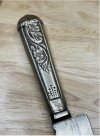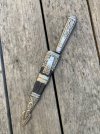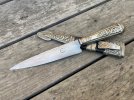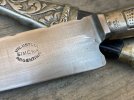Remember the Herder bayonet-style blade I showed a while ago (in post
#997), which I wanted to make a
facón out of? Well, log post coming...
As I mentioned back then, I originally wanted to pair the blade with the handle I took from an Atahualpa fork I found for cheap, but in the end I decided to wait to see if a more suitable donor would appear. So, I've been on the lookout, and it hasn't been easy because I was looking for a handle with a more subtle engraving like that of
 kamagong
kamagong
's Simbra or, alternatively, an old German handle. On top of that, I needed a matching sheath/scabbard or sheath fitttings; or at the very least a handle simple enough to look good with a simple
picaza sheath. And, of course, I didn't want to have to destroy a knife of any historical or aesthetic significance, so I was hoping to find a knife with a damaged blade, or some fittings sold separately.
Now it appears the wait is over, as I recently got lucky and found an old German dagger that will make for a great donor, made sometime after WWII and marked only with the name of the US retailer York Cutlery Co.:
Despite being an oldie, this is a knife I won't feel bad taking apart. These post-WWII import knives were often of limited quality, particularly in terms of construction and fit and finish, and that's definitely the case with this dagger. It has a faux rat-tail construction, with a fake peened tang at the end of the handle, but with what in reality is a very short tang, as I found using a magnet. Additionally, the guard fits rater poorly and the slot on the scabbard throat is very sloppy. The blade itself, though a bit too slender for the handle IMHO, appears to be of decent quality — it's chrome-plated carbon steel, so I might save it for another project, but I'd probably have to lengthen the tang.
One concern I had was that the seller claimed the handle and scabbard to be aluminum, which of course wouldn't be great in hollow format and definitely wouldn't be "historically correct" for my purposes. However, the warm tone in the pictures suggested to me that it was nickel silver, and I confirmed that when I received the knife yesterday. That's rare for German imports from this period, as cast aluminum was the main choice back then. I actually suspect that the handle and scabbard were leftovers from before the war, most likely intended for South America, as I've seen this exact same pattern in early 1900s gaucho knives. For example, below you can see it in a Uruguayan example (in fact, both knives in the picture appear to have the same handle, but the larger one appears to have it attached the wrong way, as was originally the case with my Kirschbaum
puñal from post
#1,221):
One thing I dont love is the fact that the guard is made of brass, which isn't common with
facones with nickel silver fittings. Perhaps I'll plate the guard and scabbard throat, or maybe I'll make a simpler nickel silver guard from scratch. We'll see...
I'll keep you guys updated on the process!














